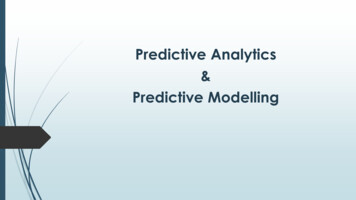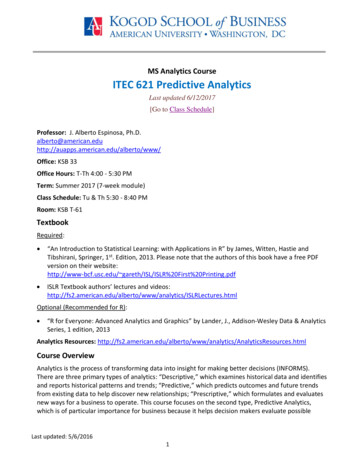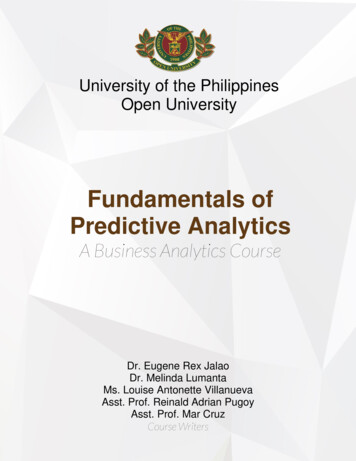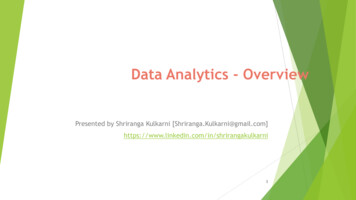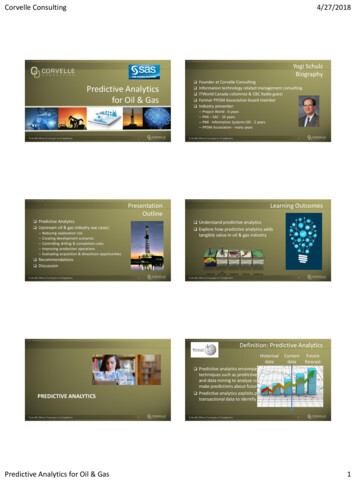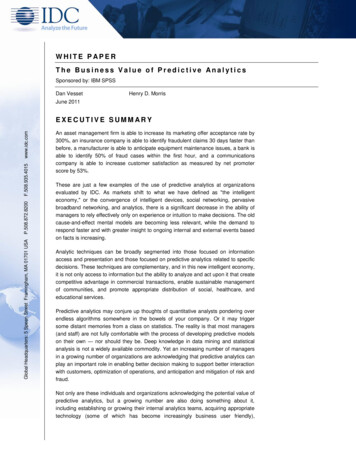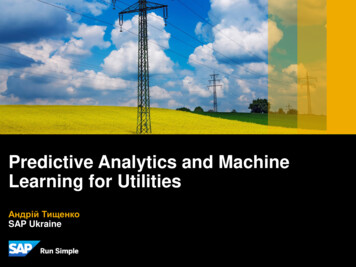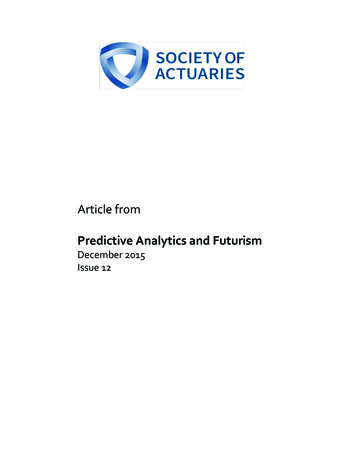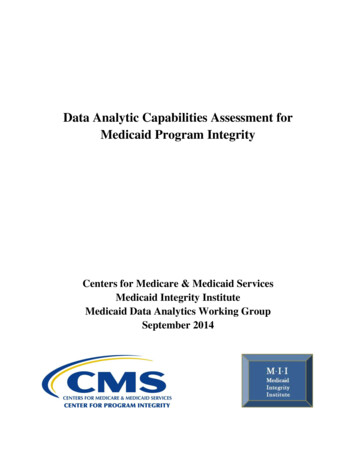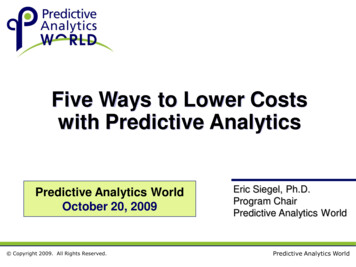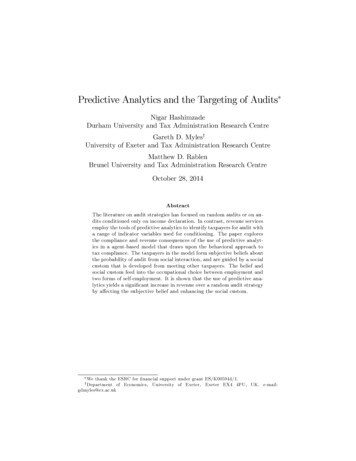
Transcription
Predictive Analytics and the Targeting of AuditsNigar HashimzadeDurham University and Tax Administration Research CentreGareth D. MylesyUniversity of Exeter and Tax Administration Research CentreMatthew D. RablenBrunel University and Tax Administration Research CentreOctober 28, 2014AbstractThe literature on audit strategies has focused on random audits or on audits conditioned only on income declaration. In contrast, revenue servicesemploy the tools of predictive analytics to identify taxpayers for audit witha range of indicator variables used for conditioning. The paper exploresthe compliance and revenue consequences of the use of predictive analytics in a agent-based model that draws upon the behavioral approach totax compliance. The taxpayers in the model form subjective beliefs aboutthe probability of audit from social interaction, and are guided by a socialcustom that is developed from meeting other taxpayers. The belief andsocial custom feed into the occupational choice between employment andtwo forms of self-employment. It is shown that the use of predictive analytics yields a signi cant increase in revenue over a random audit strategyby a ecting the subjective belief and enhancing the social custom.We thank the ESRC for nancial support under grant ES/K005944/1.of Economics, University of Exeter, Exeter EX4 4PU, UK. e-mail:gdmyles@ex.ac.uky Department
1IntroductionThe standard analysis of tax compliance in Allingham and Sandmo (1972) andYitzhaki (1974), and much of the literature that has followed, is based on theassumption that taxpayers abide by the axioms of expected utility theory andthat audits are random. An exception is the literature on optimal auditing –including Reinganum and Wilde (1985, 1986) and Chander and Wilde (1998)– which characterizes the equilibrium audit strategy as a function of reportedincome. In practice, the overwhelming majority of audits performed by revenueservices are “risk-based” (in which taxpayers are targeted for audit), with onlya small fraction of audits performed on a random basis for statistical purposes.Unlike the presumption of the optimal auditing literature, however, the targeting of risk-based audits is not based solely on the income report. Rather,revenue services rely on the experience of case o cers reviewing returns and,increasingly, on the basis of predictive analytics which applies statistical toolsto the data on a range of taxpayers’ characteristics, often in the form of indicator variables (see Cleary, 2011, and the references therein). The expectedutility model has also been subject to signi cant criticism and many alternativesmodels with behavioral foundations have been proposed.The paper explores the compliance and revenue consequences of the use ofpredictive analytics in a agent-based model that draws upon the behavioral approach to tax compliance. We use agent-based modelling because this allows usto explore a richer model than is possible in a theoretical analysis but meanswe rely on simulation to generate our results. The model is constructed on thefoundation of a social network that governs the interaction between taxpayers and the transmission of information between taxpayers. The informationconsists of attitudes towards compliance (in the form of a social custom) andbeliefs about audits (a subjective probability of audit). Taxpayers must makean occupational choice between employment and two forms of self-employmentbased on their expected income in each occupation. Employment provides asafe income but because of the third-party reporting of income there is no possibility of non-compliance. The two self-employment occupations are risky, butnon-compliance is possible. Taxpayers allocate between the occupations on thebasis of the expected income from the occupations which accounts for the optimal compliance behavior. Given the di erent levels of risk in the occupations,taxpayers are divided among occupations on the basis of risk aversion. This results in self-selection of those who will exploit opportunities for non-complianceinto occupations where such opportunities arise.The predictive analytics investigated in the model are based on Tobit andlogit regression models using the data revealed in tax returns and data fromthe outcomes of past audits. The Tobit model targets audits on the basis ofpredicted evasion level and the logit model on the basis of predicted likelihoodof non-compliance. The predictive analytics are implemented by running themodel with random audits for an initial period to acquire audit data and thenintroducing the predictive analytics to predict non-compliance. We considerthe outcome when all audits are targeted using predictive analytics and when a1
combination of targeted and random audits is employed. The "mixed" regimesof targeted and random audit are akin to the random enquiry programmes runalongside targeted audits by the US IRS and the UK HMRC. It is shown thatboth forms of predictive analytics secure a signi cant increase in revenue overa random audit strategy.To give the results validity it is necessary to build the agent-based modelon a sound underlying theory of the compliance decision. Our modelling startsfrom the assumption that taxpayers do not know the audit strategy of the revenue service but must form a belief about the probability of being audited. Thisis consistent with the idea of behavioral economics that individuals generally donot evaluate risky prospects using the objective probabilities of events but formsubjective probabilities (or transform objective probabilities using a weightingfunction). The subjective probabilities (or, in our terminology, beliefs) can differ signi cantly from the objective probability (Kahneman and Tversky, 1979).There is also empirical (Spicer and Lundstedt, 1976) and experimental (Baldry,1986) evidence that the individual compliance decision also takes into accountsocial factors such as the perceived extent of evasion in the population. Wechoose to summarize the range of social factors as the attitude of the taxpayertoward compliance. This is essentially identical to the concept of tax moralethat is prominent in the empirical literature (e.g., Torgler, 2002).A key feature of our modelling is to make explicit the processes throughwhich the attitude towards compliance and the belief about auditing are formed.Attitudes and beliefs are endogenous and result from the interaction of a taxpayer with other taxpayers and with the revenue service. The importance ofinteraction makes it necessary to specify the social environment in which theinteraction takes place. We do this by employing a social network with a givenset of links between taxpayers to govern the ‡ow of information. After eachround of audits in the simulation some of the taxpayers who are linked willmeet and exchange information. The likelihood of information transmission isgreater when the taxpayers are in the same occupation.The paper is structured as follows. Section 2 describes the separate conceptsthat are built into the model. Section 3 provides analytical details on how theseconcepts are implemented. Sections 4 and 5 describe the simulation resultsunder a random audit rule and when the audit rule is informed by predictiveanalytics. Section 6 concludes.2Conceptual ApproachThis section describes the elements that constitute the agent-based model. Thepurpose of the discussion is to relate these elements to the extensive literatureon the individual tax compliance decision. The seminal analyses of the compliance decision by Allingham and Sandmo (1972) and Yitzhaki (1974) werebuilt upon the application of expected utility theory. A standard criticism ofthis model is that it over-predicts the extent of evasion when evaluated using2
the objective probability of audit1 which has motivated the application of ideasfrom behavioral economics The behavioral models of the compliance decisionare surveyed in Hashimzade, Myles, and Tran-Nam (2013).The key elements of our agent-based model is that taxpayers make an occupational choice decision prior to the compliance decision. The compliancedecision is based on the attitude toward compliance as summarized in a socialcustom and belief about audits captured in a subjective probability of audit. Theinformation used to form attitudes and beliefs is transmitted through meetingsbetween taxpayers that a governed by a social network. Each of these components is now described in greater detail.2.1Occupational choiceOccupational choice determines the possibility of concealing income in di erent occupations. Income from employment is often subject to a withholdingtax and/or third-party reporting to the revenue service. For example, the UKPay-As-You-Earn system involves income tax being deducted by employers andremitted directly to the revenue service. The prevents evasion by employeesexcept unless there is collusion with the employer so non-compliance is onlypossible for taxpayers who are self-employed. Occupations also di er in theirtraditions concerning payment in cash. Those in which cash payment is commonprovide the greater opportunity for evasion. Occupational choice has not had aprominent role in the literature on tax evasion despite its clear importance. Exceptions to this are Pestieau and Possen (1981) who model occupational choice,and Cowell (1981), Isachsen and Strøm (1980) and Trandel and Snow (1999) whoanalyze the choice between working in the regular and the informal economies.Occupational choice is also important for the connection it has with riskaversion. Individuals allocate to occupations on the basis of their ability atthat occupation and their attitude to risk. Those who are least risk aversewill choose to enter the riskiest occupations. Kanbur (1979) and Black andde Meza (1997) assume employment is safe but self-employment is risky, andaddress the social e ciency of aggregate risk-taking. Self-employment attractsthe least risk-averse taxpayers, who will evade the most when the opportunityarises. Hence, occupational choice has the e ect of self-selecting taxpayers whowill evade into a situation in which they can evade. This observation shouldform part of any explanation of why non-compliance can be so signi cant withinspeci c occupational groups.Our model includes a choice between employment and two forms of selfemployment. Employment is a safe activity that delivers a known income. Selfemployment is risky so each taxpayer has to take into account the probabilitydistribution of income when making an occupational choice. One of the selfemployment occupations is more risky than the other, in a sense we make precisebelow2 .1 It should be noted that Slemrod (2007) gives good reasons why this claim should betreated with caution.2 Individuals di er in their level of skill in the occupations, and skills are one of the deter-3
2.2Social customsThe experiments of Baldry (1986) provide compelling evidence that the evasiondecision is not just a simple gamble. This can be rationalized by introducing anadditional cost into the evasion decision. These costs can be nancial (Bayer,2006; Lee, 2001) or psychic (Gordon 1989). Psychic costs can arise from fear ofdetection or concern about the shame of being exposed. The magnitude of thepsychic cost can re‡ect an individual’s attitude towards compliance. Attitudesare an important feature of psychological theories of tax compliance (Kirchler,Hoelzl, and Wahl, 2008; Weigel, Hessing, and El ers, 1987). The psychic costcan also be interpreted as the loss of the payo from following the social normof honest tax payment. Adopting this interpretation makes it natural to assumethat the size of the loss in payo is generated by explicit social interaction, andthat the size is larger when fewer taxpayers evade (Fortin, Lacroix, and Villeval,2007;Kim, 2003; Myles and Naylor, 1996; Traxler (2010).The additional costs have an important role in explaining some features ofthe tax evasion decision. We model attitudes by including a social custom ofhonest tax payment in the model so that there is a utility gain (relative to thestate with non-compliance) when tax is paid in full. The importance attachedto the social custom by each taxpayer is determined by their interaction withother taxpayers within the social network.2.3Subjective beliefsWe have already observed that if choice is based on objective probability of auditthen the standard model over-predicts the amount of evasion. This has led tothe application of choice models based on non-expected utility theories. Nonexpected utility models can predict the correct level of evasion for reasonableparameter values. This is because they permit the subjective probability of audit(the weighting on the payo when audited) to be greater than the objectiveprobability. They also open the possibility of designing compliance policy tomanipulate the subjective nature of the decision (El ers and Hessing, 1997).It is standard to distinguish between a choice with risk (the decision makerknows the probability distribution of future events) and a choice with uncertainty (the decision maker does not know the probabilities). A rst step awayfrom expected utility theory is to consider a choice with risk but to assume theprobabilities are distorted into “decisions weights”that enter the expected payo . Rank dependent expected utility framework (Quiggin, 1981, 1982; Quigginand Wakker, 1994) uses a particular weighting scheme to transform the objective probability of events into subjective probabilities and has been applied tothe evasion decision by Arcand and Graziosi (2005), Bernasconi (1998) and Eide(2001). Prospect theory (Kahneman and Tversky, 1979; Tversky and Kahneman, 1992) also uses a weighting scheme but payo s are determined by gainsand losses relative to a reference point. It has been applied to compliance byminants of income. This makes it necessary to state the formal details before "more risky"can be explained in full.4
al-Nowaihi and Dhami (2007), Bernasconi and Zanardi (2004), Rablen (2010),and Yaniv (1999). Uncertainty has been modelled by assuming the decisionmaker forms a probability distribution over the possible probability distributions of outcomes ("second-order uncertainty"). This gives rise to the conceptof ambiguity (surveyed in Camerer and Weber, 1992) which has been appliedby Snow and Warren (2005).We incorporate these ideas into the model by assuming that each taxpayerforms a subjective belief about the audit probability and explicitly modelling theprocess for forming beliefs. This allows the model to provide an explanation ofhow subjective probabilities can endogenously emerge and remain systematicallydi erent from the objective probabilities.2.4Social networkThe illegality of tax evasion and the incentive the revenue service has to concealits audit strategy imply that taxpayers cannot be fully informed. A naturalassumption is that information will not be revealed publicly, but will be transmitted between taxpayers in a position of mutual trust. The social network weadopt is a formalization of this assumption.The importance of social contacts is supported by empirical evidence on thepositive connection between the number of tax evaders a taxpayer knows and theextent of evasion of that taxpayer (De Juan, Lasheras, and Mayo, 1994; Geeromsand Wilmots, 1985; Spicer and Lundstedt, 1976; Wallschutzky, 1984; Webley,Robben, and Morris, 1988). This evidence demonstrates that the compliancedecision is not made in isolation but that each taxpayer makes reference to theobserved behavior of the society in which they operate.We capture this social interaction by applying network theory (Goyal, 2009;Jackson, 2004). Networks have previously been used in the analysis of evasionby. Korobow, Johnson, and Axtell (2007) and Franklin (2009). They have alsobeen applied to crime more generally (Glaeser, Sacerdote, and Scheinkman,1996).The social network in our model plays two roles. First, it transmits the socialcustom from one person to another: if two non-evaders meet the importance ofthe social custom of honest payment is increased for both, but if a non-evadermeets an evader then it is reduced for the non-evader and increased for theevader. Second, the network transmits information about audit policy. Since theaudit strategy is not public information, taxpayers have to infer it from their ownexperience and from the receipt of information about the experiences of others.Our simulations are an application of agent-based modelling (Bloomquist, 2004;Tesfatsion, 2006) with agent interaction controlled by the social network.3Network ModelIn this section we model the formation of attitudes and beliefs as the outcomeof social interaction, and opportunities as the outcome of occupational choice.5
This is achieved by applying the theory of network formation to track the linksbetween taxpayers and the transmission of attitudes and beliefs, and combining this with agent-based modelling which employs a behavioral approach todescribe individual choices.There are n individuals, indexed j 1; :::; n; interacting repeatedly in discrete time, t 1; :::; T . Each individual, j, at time t is characterized by a vectorof characteristicswj ; j ; s1j ; s2j ; zj ; p0j;t ; p1j;t ; p2j;t ; j;t :(1)At the start of the simulation values for all characteristics are randomly assigned to each taxpayer by making draws from independent distributions. The rst ve characteristics remain constant throughout the simulation. These characteristics are wj , the wage in employment (occupation 0); j , the coe cient ofrelative risk aversion; sj , the skill in self-employed occupation , 1; 2; andzj , the payo from following the social custom. The remaining four characteristics are updated through interaction with the revenue service and with othertaxpayers in the social network so are indexed by time, t. These are: pj;t , theperceived (subjective) probability of audit in occupation , 0; 1; 2, and j;t ,the weight attached to payo from the social custom.We now describe how these variables enter into the choice problem of a taxpayer and how the subjective probability and weight attached to social customare updated.In each period, t, every individual chooses their preferred occupation3 and,once income is realized, the optimal level of evasion. Individual j has a choicebetween employment or entering one of the two self-employment occupations.If employment is chosen the wage, wj , is obtained with certainty. The selfemployment opportunities are represented as risky “projects”. The outcome ofself-employment for individual j in occupation at time t is given by sj yj;twhere yj;t is a random draw at time t from the probability distribution functionF ( ). The choice of occupation is taken on the basis of F ( ) but the choice ofevasion is made after the realization of yj;t . It is assumed that E y 1 E y 2and V ar y 1 V ar y 2 , so if s1j s2j occupation 2 is riskier than occupation1 but o ers a higher expected income. Both self-employment occupations areriskier than employment, in the sense that for each agent the wage in employment is certain, i.e. V ar (wj ) 0.It is not possible to evade tax in employment because incomes are subjectto third-party reporting or to a withholding tax. Evasion only becomes possiblewhen self-employment is chosen. In occupation taxpayer j has belief at timet that the probability of evasion being detected is pj;t . The belief about theprobability of detection is updated through the experience of the taxpayer withaudits and through the exchange of information when meeting other taxpayers.The attitude of taxpayer j toward evasion is summarized in j;t , the weightgiven to the social custom. This attitude is also updated through meetings with3 It may seem unrealistic to have an occupational choice in every period but in the simulations only a very small number of taxpayers actually change occupation in any period.6
other taxpayers. We describe the processes for updating attitudes and beliefs indetail after discussing the choice of occupation for given attitudes and beliefs.The choice of occupation and the choice to evade tax involve risk. Taxpayerj has a (constant) degree of relative risk aversion measured by the risk aversion parameter, j . The taxpayer chooses occupation and evasion level at timet to maximize subjective expected utility given beliefs fpj;t g. For analyticaltractability, we assume throughout a CRRA form for utility:1YjU (Yj ) 1j1:(2)jThe attitude toward evasion determines the utility value of following the socialcustom of honest tax payment. The payo from the social custom is given byzj and the individual weight, or the importance, assigned to this payo by thetaxpayer is determined by j;t . Hence, compliance with tax payment at time tgenerates an additional utility from the social custom of j;t zj .In employment there is no opportunity for evasion so the taxpayer obtainsa payo given by1[(1)wj ] j 1V0 j;t zj ;(3)1jwhere is the constant marginal tax rate. The possibility of tax evasion makesthe choice of self-employment a compound lottery: the outcome of the projectis random, as is the outcome of choosing to evade.De ne the expected payo from the optimal choice of evasion in self-employmentoccupation for a given realization yj;t asVeyj;t maxiEji 2[0;sij yj;t] (1pj;t U sj yj;tf Ejpj;t )U sj yj;t Ej j;t zj 1[Eji 0]o;(4)where f 1 is the ne levied on unpaid tax if evasion is detected. The term1[A] is an indicator function that takes the value of one if A is true and zerootherwise: the payo from the social custom is obtained only if tax is paid infull. The level of evasion will be a function Ej yj;t of the realized income yj;tin occupation . The expected payo from the compound lottery describingoccupation is thenZV Ve (y) dF (y) :(5)YThe choice of occupation is made by comparing the utility levels from employment and from self-employment. Hence, the chosen occupation is given byselecting the maximum of V 0 ; V 1 ; V 2 .After self-employment occupation is chosen at time t an outcome y j;t isrealized according to the probability distribution function F ( ). Given the outcome, the optimal evasion decision is implemented, as described above. Denote7
Ethe level of evasion that is realized by E j;t . Tax returns are submitj;tj;t yted, and a number of those in self-employment occupations are then audited,according to a process chosen by the revenue service. If evasion is discovered,unpaid tax is reclaimed and the ne at rate f is imposed on unpaid tax.The social network is modelled as a set of bidirectional links described byan n n symmetric matrix of zeros and ones. For example, in the networkdescribed by matrix A230 1 0 06 1 0 1 0 77(6)A 64 0 1 0 1 5:0 0 1 0the rst row, representing the links of individual 1, has a single 1 in column2 which means that 1 is linked to 2. There is a corresponding 1 in the rstcolumn in the second row representing the links of individual 2 with 1. That is,the element in row i and column j of matrix A is de ned asAij 10if i and j are linked in the network,otherwise.In the simulation, the matrix is created at the outset and does not change.4The network determines who may meet whom to exchange information. Ineach period a random selection of meetings occur described by a matrix C tof zeros and ones which is randomly selected every period. Individuals i andtj meet during period t if Aij Cij 1. At a meeting of i and j there is aprobability that information is exchanged about the subjective probability ofaudit and whether the taxpayer was compliant in that period. The probabilityof information exchange depends on the occupational groups to which i and jbelong; the probability is highest when they are in the same occupation. Let i beengaged in occupation and j in occupation . The probabilities of informationexchange occurring at a meeting are given by q where ; 0; 1; 2.Recall that individuals hold beliefs about the probability of being audited ineach of the three occupations. We assume there are two ways in which beliefsare updated. Consider taxpayer j who has worked in occupation in period t.After submission of the tax return, the taxpayer may or may not be audited.On the basis of the outcome the belief about the audit probability, pj;t , in thatoccupation is then adjusted. The beliefs about the audit probability in theother two occupations, pj;t ; 6 , remain unchanged at this stage. Followingthis, the taxpayer may meet with a contact in the network. Let the meeting bewith a taxpayer who is engaged in occupation . At the meeting informationis exchanged with probability q . This information is then used to update thebelief about the audit probability, pj;t ; in the occupation of the contact. Theother two beliefs remain unchanged since no information is communicated.4 Here the network is xed, but the probabilities of information exchange between the linkedindividuals change if they switch occupations, as described below. Another possibility wouldbe to have the network itself revised as a consequence of chosen actions, i.e. agents in di erentoccupations belonging to di erent social networks.8
The choice of occupation in period t 1 is made on the basis of the beliefsp0j;t ; p1j;t ; p2j;t updated after the audits and the information exchange. Twodi erent processes for the updating of subjective beliefs following an audit areconsidered. As studies have reliably demonstrated important deviations fromBayesian inference (e.g. Grether, 1980), we allow for non-Bayesian updating.The rst process, which is qualitatively similar to a Bayesian process, is toassume that individuals feel marked as targets if they are audited, so that oneaudit is believed likely to be followed by another. We term this the target e ect.In contrast, those not audited in a period believe they are less likely to be auditedin the next period. Formally, if audited in period t, an individual’s belief aboutbeing audited in the next period is raised to probability P , otherwise it decays.The updating rule for the subjective probability is thereforep j;t 1 AXj;t P (1p j;t 1 pj;t 1 ;Aj;t ) pj;t ;2 [0; 1] ; P 2 [0; 1](7)6 :where Aj;t 1 if taxpayer j was audited in period t and Aj;t 0 otherwise.This can also be written asP 2 [0; 1]if audited at t;pj;t 1 ; d 2 [0; 1] otherwise.p j;t 1 (8)We refer to the case of P 1 as the maximal target e ect.As an alternative, we have also considered a second process that capturesthe bomb-crater e ect documented experimentally by Guala and Mittone (2005),Kastlunger, Kirchler, Mittone, and Pitters (2009), Maciejovsky, Kirchler, andSchwarzenberger (2007) and Mittone (2006). In this process a taxpayer who hasbeen audited in one period believes that they are less likely to be audited in thenext (or not audited at all), but the belief slowly rises over time. The processis therefore described byp j;t 1 pj;t 1P 2 [0; 1]pj;t 1 ;if audited at t;2 [0; 1] otherwise,(9)with P 0 being the maximal bomb-crater e ect.After the audit process is completed the taxpayer may meet with a contact.The information that may (or may not) be exchanged at a meeting includesthe subjective probabilities and whether or not the agents were audited. Iftaxpayer j in occupation meets individual i who works in occupation andif information exchange occurs at the meeting, the subjective probability isupdated according to the rulepj;t 1 pj;t 1 p j;t ;p j;t (1if) p i;t ; if ;(10)6 :The importance assigned to the social custom is also determined by interaction in the social network. The weight, j;t , is updated in period t if information9
exchange occurs between j and some other taxpayer in that period. Assume individual j meets individual i at time t and information exchange takes place.The updating process is described byih1(11) 0] ;j;t 1 j;t M (j) 1[EiM (j) 1where M (j) is the number of previous meetings for j at which information was is the level of evasion of i. Hence, j;t 1 j;t if informationexchanged and Eiis exchanged with an compliant taxpayer, and j;t 1 j;t if information isexchanged with an evader.4Baseline SimulationsWe rst conduct a simulation of the network model described above under theassumption of random audits to obtain a baseline outcome. This allow an investigation of the nature of the equilibrium and the consequences of the alternativeupdating rules for beliefs.The results we present assume the target e ect for audits as speci ed inequation (8). The results for the bomb-crater model di er only in the patternof compliance after audit, as described below; the outcomes for the revenuesare not qualitatively di erent from those under the target e ect. A completeset of results for the bomb-crater model are available from the authors uponrequest. The parameter values and the distributions for the random variablesthat remain constant across the simulations are given in the Appendix. Asseems realistic, we set the parameter values such that, on average, the payo from self-employment will exceed that from employment.5We assume that earnings in occupation , 0; 1; 2, are drawn from lognormal distribution, log N ( ; 2 ), and that skills in self-employment are drawnfrom 1 1 U , where U is a uniform [0; 1] random variable, and 2 (0; 1) is a con0stant parameter. Each individual knows their wage in employment, yj;t wj ,iskill, sj ; in the self-employment occupations i 1; 2:, and the distribution ofoutcomes, F ( ) ; in the self-employed occupations. Each individual is randomly assigned a vector of subjective beliefs, p0j;0 ; p1j;0 ; p2j;0 , and the level ofimportance of social custom, j;0 , at time 0, from a uniform [0; 1] distribution.The probability of a random audit for all self-employed is 0:05; the employedare not audited.The results of the simulations for random audits are illustrated in Figure1 and provide the baseline against which to assess
the compliance and revenue consequences of the use of predictive analyt-ics in a agent-based model that draws upon the behavioral approach to tax compliance. The taxpayers in the model form subjective beliefs about the probability of audit from social interaction, and are guided by a social custom that is developed from meeting other taxpayers.


